Kaiwei Wang
OneOcc: Semantic Occupancy Prediction for Legged Robots with a Single Panoramic Camera
Nov 05, 2025Abstract:Robust 3D semantic occupancy is crucial for legged/humanoid robots, yet most semantic scene completion (SSC) systems target wheeled platforms with forward-facing sensors. We present OneOcc, a vision-only panoramic SSC framework designed for gait-introduced body jitter and 360{\deg} continuity. OneOcc combines: (i) Dual-Projection fusion (DP-ER) to exploit the annular panorama and its equirectangular unfolding, preserving 360{\deg} continuity and grid alignment; (ii) Bi-Grid Voxelization (BGV) to reason in Cartesian and cylindrical-polar spaces, reducing discretization bias and sharpening free/occupied boundaries; (iii) a lightweight decoder with Hierarchical AMoE-3D for dynamic multi-scale fusion and better long-range/occlusion reasoning; and (iv) plug-and-play Gait Displacement Compensation (GDC) learning feature-level motion correction without extra sensors. We also release two panoramic occupancy benchmarks: QuadOcc (real quadruped, first-person 360{\deg}) and Human360Occ (H3O) (CARLA human-ego 360{\deg} with RGB, Depth, semantic occupancy; standardized within-/cross-city splits). OneOcc sets new state-of-the-art (SOTA): on QuadOcc it beats strong vision baselines and popular LiDAR ones; on H3O it gains +3.83 mIoU (within-city) and +8.08 (cross-city). Modules are lightweight, enabling deployable full-surround perception for legged/humanoid robots. Datasets and code will be publicly available at https://github.com/MasterHow/OneOcc.
NTIRE 2025 Challenge on Event-Based Image Deblurring: Methods and Results
Apr 16, 2025Abstract:This paper presents an overview of NTIRE 2025 the First Challenge on Event-Based Image Deblurring, detailing the proposed methodologies and corresponding results. The primary goal of the challenge is to design an event-based method that achieves high-quality image deblurring, with performance quantitatively assessed using Peak Signal-to-Noise Ratio (PSNR). Notably, there are no restrictions on computational complexity or model size. The task focuses on leveraging both events and images as inputs for single-image deblurring. A total of 199 participants registered, among whom 15 teams successfully submitted valid results, offering valuable insights into the current state of event-based image deblurring. We anticipate that this challenge will drive further advancements in event-based vision research.
Low-Light Image Enhancement using Event-Based Illumination Estimation
Apr 13, 2025Abstract:Low-light image enhancement (LLIE) aims to improve the visibility of images captured in poorly lit environments. Prevalent event-based solutions primarily utilize events triggered by motion, i.e., ''motion events'' to strengthen only the edge texture, while leaving the high dynamic range and excellent low-light responsiveness of event cameras largely unexplored. This paper instead opens a new avenue from the perspective of estimating the illumination using ''temporal-mapping'' events, i.e., by converting the timestamps of events triggered by a transmittance modulation into brightness values. The resulting fine-grained illumination cues facilitate a more effective decomposition and enhancement of the reflectance component in low-light images through the proposed Illumination-aided Reflectance Enhancement module. Furthermore, the degradation model of temporal-mapping events under low-light condition is investigated for realistic training data synthesizing. To address the lack of datasets under this regime, we construct a beam-splitter setup and collect EvLowLight dataset that includes images, temporal-mapping events, and motion events. Extensive experiments across 5 synthetic datasets and our real-world EvLowLight dataset substantiate that the devised pipeline, dubbed RetinEV, excels in producing well-illuminated, high dynamic range images, outperforming previous state-of-the-art event-based methods by up to 6.62 dB, while maintaining an efficient inference speed of 35.6 frame-per-second on a 640X480 image.
EgoEvGesture: Gesture Recognition Based on Egocentric Event Camera
Mar 16, 2025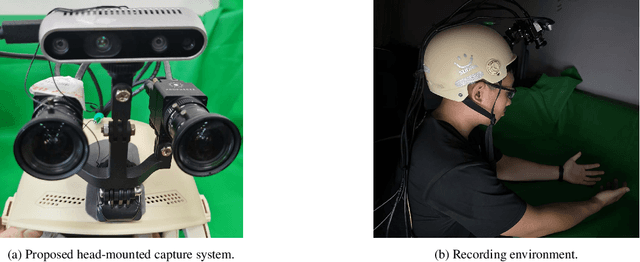
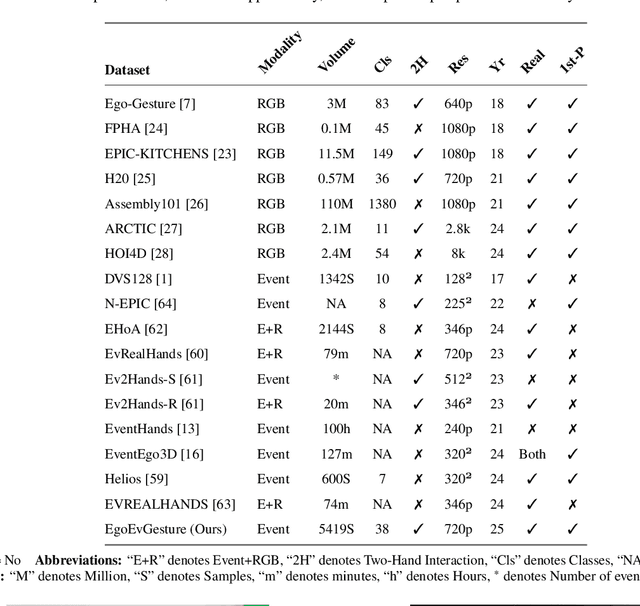
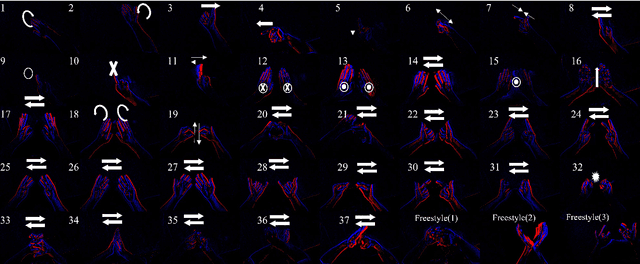
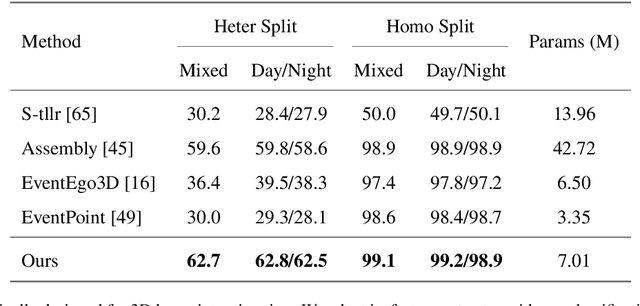
Abstract:Egocentric gesture recognition is a pivotal technology for enhancing natural human-computer interaction, yet traditional RGB-based solutions suffer from motion blur and illumination variations in dynamic scenarios. While event cameras show distinct advantages in handling high dynamic range with ultra-low power consumption, existing RGB-based architectures face inherent limitations in processing asynchronous event streams due to their synchronous frame-based nature. Moreover, from an egocentric perspective, event cameras record data that include events generated by both head movements and hand gestures, thereby increasing the complexity of gesture recognition. To address this, we propose a novel network architecture specifically designed for event data processing, incorporating (1) a lightweight CNN with asymmetric depthwise convolutions to reduce parameters while preserving spatiotemporal features, (2) a plug-and-play state-space model as context block that decouples head movement noise from gesture dynamics, and (3) a parameter-free Bins-Temporal Shift Module (BSTM) that shifts features along bins and temporal dimensions to fuse sparse events efficiently. We further build the EgoEvGesture dataset, the first large-scale dataset for egocentric gesture recognition using event cameras. Experimental results demonstrate that our method achieves 62.7% accuracy in heterogeneous testing with only 7M parameters, 3.1% higher than state-of-the-art approaches. Notable misclassifications in freestyle motions stem from high inter-personal variability and unseen test patterns differing from training data. Moreover, our approach achieved a remarkable accuracy of 96.97% on DVS128 Gesture, demonstrating strong cross-dataset generalization capability. The dataset and models are made publicly available at https://github.com/3190105222/EgoEv_Gesture.
Omnidirectional Multi-Object Tracking
Mar 06, 2025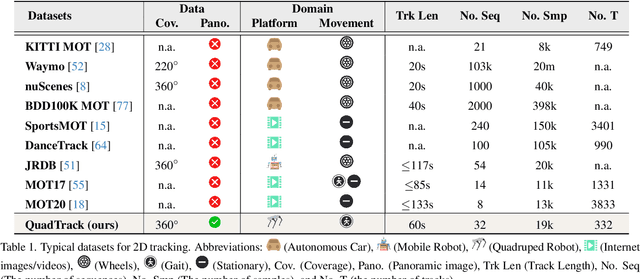
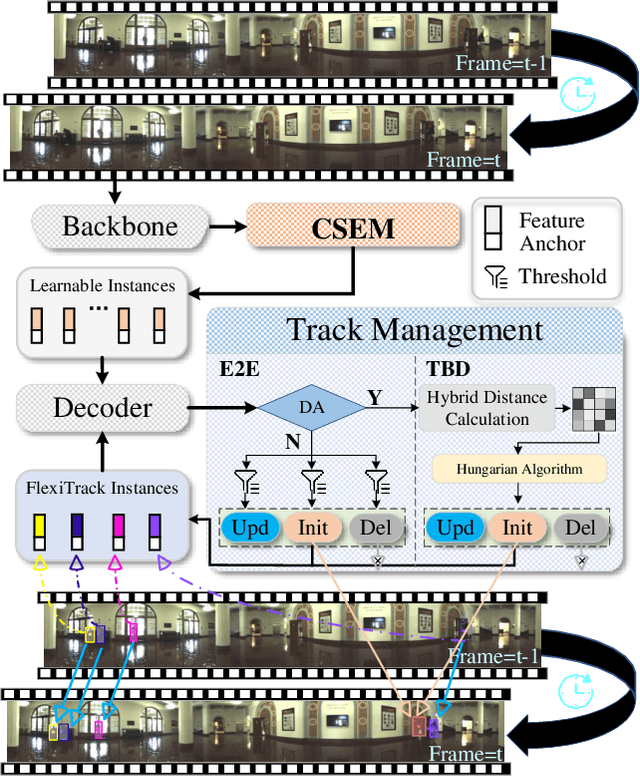
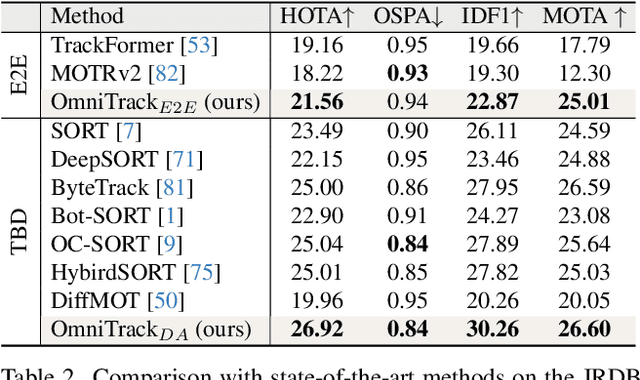

Abstract:Panoramic imagery, with its 360{\deg} field of view, offers comprehensive information to support Multi-Object Tracking (MOT) in capturing spatial and temporal relationships of surrounding objects. However, most MOT algorithms are tailored for pinhole images with limited views, impairing their effectiveness in panoramic settings. Additionally, panoramic image distortions, such as resolution loss, geometric deformation, and uneven lighting, hinder direct adaptation of existing MOT methods, leading to significant performance degradation. To address these challenges, we propose OmniTrack, an omnidirectional MOT framework that incorporates Tracklet Management to introduce temporal cues, FlexiTrack Instances for object localization and association, and the CircularStatE Module to alleviate image and geometric distortions. This integration enables tracking in large field-of-view scenarios, even under rapid sensor motion. To mitigate the lack of panoramic MOT datasets, we introduce the QuadTrack dataset--a comprehensive panoramic dataset collected by a quadruped robot, featuring diverse challenges such as wide fields of view, intense motion, and complex environments. Extensive experiments on the public JRDB dataset and the newly introduced QuadTrack benchmark demonstrate the state-of-the-art performance of the proposed framework. OmniTrack achieves a HOTA score of 26.92% on JRDB, representing an improvement of 3.43%, and further achieves 23.45% on QuadTrack, surpassing the baseline by 6.81%. The dataset and code will be made publicly available at https://github.com/xifen523/OmniTrack.
One-Step Event-Driven High-Speed Autofocus
Mar 03, 2025



Abstract:High-speed autofocus in extreme scenes remains a significant challenge. Traditional methods rely on repeated sampling around the focus position, resulting in ``focus hunting''. Event-driven methods have advanced focusing speed and improved performance in low-light conditions; however, current approaches still require at least one lengthy round of ``focus hunting'', involving the collection of a complete focus stack. We introduce the Event Laplacian Product (ELP) focus detection function, which combines event data with grayscale Laplacian information, redefining focus search as a detection task. This innovation enables the first one-step event-driven autofocus, cutting focusing time by up to two-thirds and reducing focusing error by 24 times on the DAVIS346 dataset and 22 times on the EVK4 dataset. Additionally, we present an autofocus pipeline tailored for event-only cameras, achieving accurate results across a range of challenging motion and lighting conditions. All datasets and code will be made publicly available.
Event-aided Semantic Scene Completion
Feb 04, 2025



Abstract:Autonomous driving systems rely on robust 3D scene understanding. Recent advances in Semantic Scene Completion (SSC) for autonomous driving underscore the limitations of RGB-based approaches, which struggle under motion blur, poor lighting, and adverse weather. Event cameras, offering high dynamic range and low latency, address these challenges by providing asynchronous data that complements RGB inputs. We present DSEC-SSC, the first real-world benchmark specifically designed for event-aided SSC, which includes a novel 4D labeling pipeline for generating dense, visibility-aware labels that adapt dynamically to object motion. Our proposed RGB-Event fusion framework, EvSSC, introduces an Event-aided Lifting Module (ELM) that effectively bridges 2D RGB-Event features to 3D space, enhancing view transformation and the robustness of 3D volume construction across SSC models. Extensive experiments on DSEC-SSC and simulated SemanticKITTI-E demonstrate that EvSSC is adaptable to both transformer-based and LSS-based SSC architectures. Notably, evaluations on SemanticKITTI-C demonstrate that EvSSC achieves consistently improved prediction accuracy across five degradation modes and both In-domain and Out-of-domain settings, achieving up to a 52.5% relative improvement in mIoU when the image sensor partially fails. Additionally, we quantitatively and qualitatively validate the superiority of EvSSC under motion blur and extreme weather conditions, where autonomous driving is challenged. The established datasets and our codebase will be made publicly at https://github.com/Pandapan01/EvSSC.
Benchmarking the Robustness of Optical Flow Estimation to Corruptions
Nov 22, 2024



Abstract:Optical flow estimation is extensively used in autonomous driving and video editing. While existing models demonstrate state-of-the-art performance across various benchmarks, the robustness of these methods has been infrequently investigated. Despite some research focusing on the robustness of optical flow models against adversarial attacks, there has been a lack of studies investigating their robustness to common corruptions. Taking into account the unique temporal characteristics of optical flow, we introduce 7 temporal corruptions specifically designed for benchmarking the robustness of optical flow models, in addition to 17 classical single-image corruptions, in which advanced PSF Blur simulation method is performed. Two robustness benchmarks, KITTI-FC and GoPro-FC, are subsequently established as the first corruption robustness benchmark for optical flow estimation, with Out-Of-Domain (OOD) and In-Domain (ID) settings to facilitate comprehensive studies. Robustness metrics, Corruption Robustness Error (CRE), Corruption Robustness Error ratio (CREr), and Relative Corruption Robustness Error (RCRE) are further introduced to quantify the optical flow estimation robustness. 29 model variants from 15 optical flow methods are evaluated, yielding 10 intriguing observations, such as 1) the absolute robustness of the model is heavily dependent on the estimation performance; 2) the corruptions that diminish local information are more serious than that reduce visual effects. We also give suggestions for the design and application of optical flow models. We anticipate that our benchmark will serve as a foundational resource for advancing research in robust optical flow estimation. The benchmarks and source code will be released at https://github.com/ZhonghuaYi/optical_flow_robustness_benchmark.
EI-Nexus: Towards Unmediated and Flexible Inter-Modality Local Feature Extraction and Matching for Event-Image Data
Oct 29, 2024



Abstract:Event cameras, with high temporal resolution and high dynamic range, have limited research on the inter-modality local feature extraction and matching of event-image data. We propose EI-Nexus, an unmediated and flexible framework that integrates two modality-specific keypoint extractors and a feature matcher. To achieve keypoint extraction across viewpoint and modality changes, we bring Local Feature Distillation (LFD), which transfers the viewpoint consistency from a well-learned image extractor to the event extractor, ensuring robust feature correspondence. Furthermore, with the help of Context Aggregation (CA), a remarkable enhancement is observed in feature matching. We further establish the first two inter-modality feature matching benchmarks, MVSEC-RPE and EC-RPE, to assess relative pose estimation on event-image data. Our approach outperforms traditional methods that rely on explicit modal transformation, offering more unmediated and adaptable feature extraction and matching, achieving better keypoint similarity and state-of-the-art results on the MVSEC-RPE and EC-RPE benchmarks. The source code and benchmarks will be made publicly available at https://github.com/ZhonghuaYi/EI-Nexus_official.
E-3DGS: Gaussian Splatting with Exposure and Motion Events
Oct 22, 2024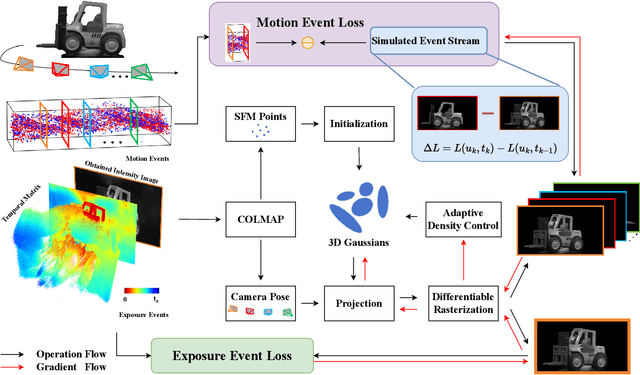
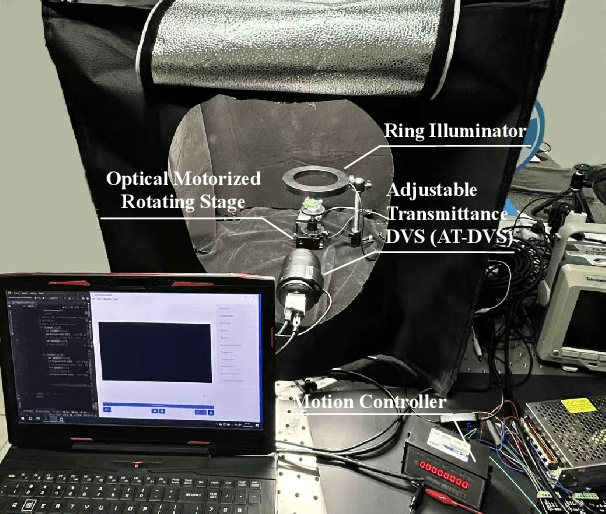
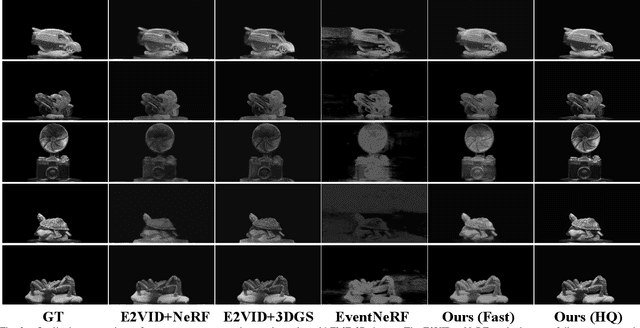
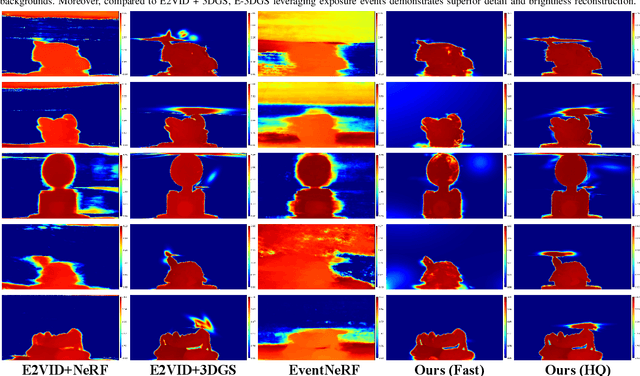
Abstract:Estimating Neural Radiance Fields (NeRFs) from images captured under optimal conditions has been extensively explored in the vision community. However, robotic applications often face challenges such as motion blur, insufficient illumination, and high computational overhead, which adversely affect downstream tasks like navigation, inspection, and scene visualization. To address these challenges, we propose E-3DGS, a novel event-based approach that partitions events into motion (from camera or object movement) and exposure (from camera exposure), using the former to handle fast-motion scenes and using the latter to reconstruct grayscale images for high-quality training and optimization of event-based 3D Gaussian Splatting (3DGS). We introduce a novel integration of 3DGS with exposure events for high-quality reconstruction of explicit scene representations. Our versatile framework can operate on motion events alone for 3D reconstruction, enhance quality using exposure events, or adopt a hybrid mode that balances quality and effectiveness by optimizing with initial exposure events followed by high-speed motion events. We also introduce EME-3D, a real-world 3D dataset with exposure events, motion events, camera calibration parameters, and sparse point clouds. Our method is faster and delivers better reconstruction quality than event-based NeRF while being more cost-effective than NeRF methods that combine event and RGB data by using a single event sensor. By combining motion and exposure events, E-3DGS sets a new benchmark for event-based 3D reconstruction with robust performance in challenging conditions and lower hardware demands. The source code and dataset will be available at https://github.com/MasterHow/E-3DGS.
 Add to Chrome
Add to Chrome Add to Firefox
Add to Firefox Add to Edge
Add to Edge